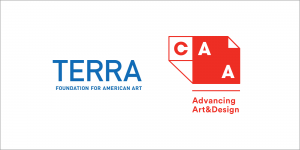CAA News Today
Announcing the Appointment of Two New Editors for CAA Publications
posted by CAA — Jul 23, 2021
We’re pleased to announce the appointment of two new editors for CAA publications: Christy Anderson, was selected to be Editor-in-Chief of The Art Bulletin. Balbir Singh will take the post as Reviews Editor of Art Journal. They begin their three-year terms July 1, 2022. Learn more about their work below.
EDITOR BIOGRAPHIES
Christy Anderson | Incoming Editor-in-Chief of The Art Bulletin
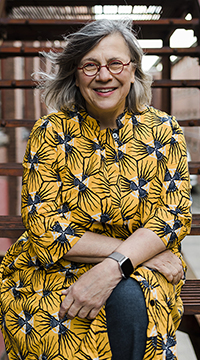 Christy Anderson is an architectural historian with a special interest in the buildings of Renaissance and Baroque Europe. Professor Anderson has taught at Yale University, the Courtauld Institute, MIT, and the University of Toronto. At Yale she received a Morse Faculty Fellowship as well as numerous teaching prizes. She received her Ph.D. from the School of Architecture at the Massachusetts Institute of Technology. As a Kress Fellow at the Courtauld Institute of Art and later as a Research Fellow at Worcester College, Oxford University, she studied the annotations made by the English architect Inigo Jones (1573–1652) in his collection of treatises and humanist literature. This work on literacy, architectural language, and the construction of the professional architect appeared in her book Inigo Jones and the Classical Tradition (Cambridge, 2006).
Christy Anderson is an architectural historian with a special interest in the buildings of Renaissance and Baroque Europe. Professor Anderson has taught at Yale University, the Courtauld Institute, MIT, and the University of Toronto. At Yale she received a Morse Faculty Fellowship as well as numerous teaching prizes. She received her Ph.D. from the School of Architecture at the Massachusetts Institute of Technology. As a Kress Fellow at the Courtauld Institute of Art and later as a Research Fellow at Worcester College, Oxford University, she studied the annotations made by the English architect Inigo Jones (1573–1652) in his collection of treatises and humanist literature. This work on literacy, architectural language, and the construction of the professional architect appeared in her book Inigo Jones and the Classical Tradition (Cambridge, 2006).
Learn more about The Art Bulletin.
Balbir Singh | Incoming Reviews Editor of Art Journal
 Balbir Singh’s scholarship focuses on the convergence of racial, gendered, and religious embodiment, with migration and policing under violent conditions of imperial and domestic security technologies. She is at work on her first book, “Militant Bodies: Violence and Visual Culture under Islamophobia,” which is rooted in questions that center post-9/11 racial and religious hyper-policing of Muslims and Sikhs, especially as they relate to bodily comportment and the donning of religious garments. Additionally, she is beginning research on a second book project — “Whose Terror? Vexed Attachments and the Contradictions of Freedom.”
Balbir Singh’s scholarship focuses on the convergence of racial, gendered, and religious embodiment, with migration and policing under violent conditions of imperial and domestic security technologies. She is at work on her first book, “Militant Bodies: Violence and Visual Culture under Islamophobia,” which is rooted in questions that center post-9/11 racial and religious hyper-policing of Muslims and Sikhs, especially as they relate to bodily comportment and the donning of religious garments. Additionally, she is beginning research on a second book project — “Whose Terror? Vexed Attachments and the Contradictions of Freedom.”
Meet the 2021 Recipients of Terra Foundation for American Art Research Travel Grants
posted by CAA — Jul 19, 2021
We’re delighted to announce fourteen scholars have been awarded Terra Foundation for American Art Research Travel Grants in 2021.
These grants provide support to doctoral, postdoctoral, and senior scholars from both the US and outside the US for research topics dedicated to the art and visual culture of the United States prior to 1980.
International Research Travel Grants for US-based Scholars
Doctoral Scholars
Thomas Busciglio-Ritter, The University of Delaware, “‘The Union of Excellences’: An Atlantic History of Early American Landscape Views (1790–1860)”
Ann Tartsinis, Stanford University, “Modernism in Pieces: Transatlantic Visual Culture Between the Wars”
Postdoctoral & Senior Scholars
Caroline Riley, Boston University, “Thérèse Bonney’s Photography: The Politics of Art, the Body,and War from 1920–1970”
Nadia Sethi, University of Washington, “Alaska Native Cultural Belongings held in Museums in Estonia, Finland and Sweden”
Kay Wells, University of Wisconsin-Milwaukee, “Uncanny Revivals: Designing Early America during the Rise of Fascism”
International Research Travel Grants to the United States
Doctoral Scholars
Max Böhner, Humboldt-Universität zu Berlin, Germany, “Twilight Aesthetics: Queer Visual Culture in the United States Between 1945 and 1969”
Sarah Happersberger, Justus-Liebig-Universität Giessen, Germany, “Connection, Community, Kinship, Network: Women Artists Performing Togetherness in the Long 1970s”
Jacqueline Mabey, University College London, England, “This Must Be the Place: Mapping Artistic Kinship and Economic Change in Downtown New York, 1973–1987”
Ana Gabriela Rodriguez, The Courtauld Institute of Art, England, “Tracing Puerto Rican Graphic Arts: Bridging Workshops and Crossing Borders, 1940s –1970s”
Frances Varley, The Courtauld Institute of Art, England, “Identity, Provincialism and Modernism in the US and Britain from a Comparative Perspective, c. 1870–1914”
Wen Yao, The University of York, England, “A Travelling Surrealist: Mobility and Representation in Stella Snead’s Paintings, Photographs and Collages Made in the US (1940–1980)”
Postdoctoral & Senior Scholars
Dafne Cruz Porchini, Universidad Nacional Autónoma de México, “Jean Charlot: A French Artist in the United States and Mexico (1921–1944)”
Maria Stavrinaki, Université Paris I Panthéon–Sorbonne, France, “‘After History’: Variations on a Theme in the Art and Thought of the 1950s–1960s”
Emily Warner, Independent Scholar, “Abstraction Unframed: Abstract Murals at Midcentury”
Learn more about the Terra Foundation Research Travel Grants
Remembering Rick Asher
posted by CAA — Jul 13, 2021
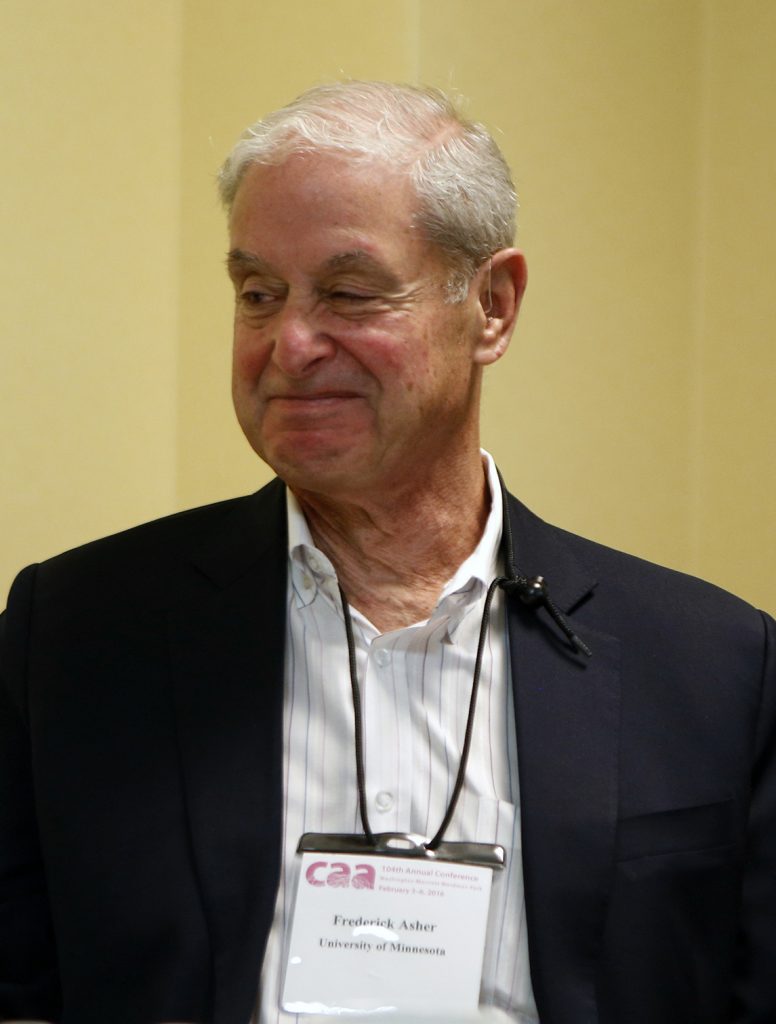
Rick Asher. Photograph by Ben Fractenberg.
Frederick M. Asher, beacon of collegiality and builder of institutions, died on June 26, 2021, having turned 80 just one month earlier. His generosity of spirit guided many scholars through their graduate years and beyond: at the University of Minnesota, where he spent his academic career, and around the world. With Catherine B. Asher, his wife and fellow historian of South Asian art, he led initiatives to document and preserve images of art, archaeological, and architectural objects and sites in India; mentored numerous colleagues and students; and contributed his energies to making academic organizations flourish across the world. He was an early, active member of the American Council for Southern Asian Art (ACSAA); served as president of the American Institute of Indian Studies; and played many roles at CAA, most recently as part of the CAA-Getty International Program where his energies encouraged many of us to reach out across physical and intellectual distances to begin new conversations.
His early research, published in 1980 as The Art of Eastern India, 300–800 (Minnesota), draws connections across the Gupta and Pala eras, thinking deeply about continuities across media—terracotta, bronze, and stone—and across belief systems. His subsequent research led him to study contemporary sculptural practices as a way of understanding the work of unnamed historical sculptors and to a deep engagement with the materiality, crafting, and afterlives of both sculptural objects and the sites where they were worshipped and excavated. His final book, Sarnath: A Critical History of the Place Where Buddhism Began (Getty 2020), published just months before his death, focused on the place where the historical Buddha preached his first sermon, tracing the establishment, excavation, and reimagining of the monastic site from that founding moment to the present. In April, Rick discussed the book with James Cuno for a Getty podcast, giving us a glimpse into his intellectual process and offering many of us a reminder of the rhythms of his class lectures. With his students, Rick always ran toward questions and tantalizing bits of information, wondering at what we don’t know about the past and at the same time marveling at contemporary uses of ancient sculptures and sites. At Sarnath, this meant both the tourists shuttling in from Varanasi with their local guides (guides who almost certainly had met Rick and discussed their mutual love of the site with him) and the international monastic Buddhist communities with pilgrimage centers nearby. Rick cared deeply about his students, and his engaging, dynamic teaching was renowned. He received the University of Minnesota’s Morse-Alumni Undergraduate Teaching Award in 2005–2006, one of his most treasured moments of recognition.
I was incredibly fortunate to visit Sarnath for the first time with Rick and Cathy as part of a trip they organized for the cohort of graduate students in the late 1990s. The trip was exemplary of the Ashers’ generosity and openness—recognizing the hurdles associated with pursuing academic research in India, they sought to pass on their extensive experience by offering us the opportunity to shadow them in their respective projects. Rick had been working with a scientist at the University of Minnesota to ascertain the locations of quarries for various Pala-era (8th–12th century) sculptures by matching stone samples. The project focused on both the materiality and the process of crafting the sculptures—he considered how stone was separated from the earth, how it would have been chosen for a sculpture, and then how it was carefully carved with the detailed iconographies of a Vishnu or a Tara.1 The project’s success relied on his ability to bring people together in a common project: Rick recruited curators and conservators at museums around the world to undertake the delicate process of excising a thin section from the back of these sculptures to compare to the samples he gathered from quarries in Bihar and Bengal. It was this latter piece of the project that he embarked on that summer, taking two of us green graduate students with him into remote areas of Bihar, where we stayed in dak bungalows (remnants of the nineteenth-century postal system) and revisited many of his early research sites from his own graduate days. Rick’s enthusiasm for reconnecting with the people of the region and introducing us to them still resonates with me today, guiding my own fieldwork experiences beyond the inert object to understand the deep interconnections between art, history, and the people who made and continue to interact with the “works of art” we study, works that remain very much alive in the present.
Rick had an incredible gift for open and positive leadership. He hosted ACSAA’s first conference in 1981, and he made sure that the group served as a space of warm, collegial exchange as it grew over the decades. He attended every conference, symposium, workshop, and meeting, seeking out the panels where colleagues and former students were presenting. He would often ask the first question, to draw out commonalities across a diverse panel and also, I came to realize, to facilitate discussion and to give everyone else in the audience time to formulate their own questions. It was primarily at conferences that he would make connections between scholars, a kind of academic matchmaking, if you will. One of the truths of my academic life is that if we have met, Rick probably introduced us. He would stride over, beaming, happy to see you, and then almost immediately say, “there’s someone here you should meet.” Then he would bound off, urging you to follow, to joyfully connect you to a towering senior scholar or newly minted PhD, offering a few choice intellectual threads to solidify the link. Rick understood that the big institutions—CAA prominent among them—only worked because of the dedication of an interconnected group of individuals who recognized their shared commitment to the field. These introductions wove the fabric of these institutions such that when he passed, my email inbox was filled with loving notes and remembrances from colleagues around the world—his colleagues, and also, because of him, my colleagues.
Rick, whose intellectual pursuits focused on the material connections between works of art and people and who cared deeply for makers of objects and sites and the ways in which places and people shaped one another over time, thus continues to connect us even at the moment of his passing. His own post-history has yet to be written, but I have a strong feeling that his energy and presence will be with us at each future academic meeting, in each future encounter. So wonderful to see you! Come, there’s someone here you should meet.
–Rebecca M. Brown, Johns Hopkins University
In Memory of Moira Roth
posted by CAA — Jun 29, 2021
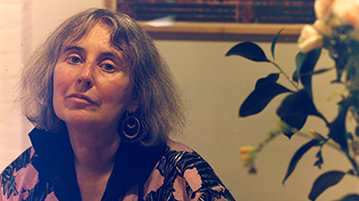
Moira Roth, photo by Max Kozloff, courtesy of Sue Heinemann
Moira Roth, one of the last of the founding generation of feminist art historians, died on June 14, 2021, at the age of 87. Famously warm, gracious, and charming, Roth was an outsized figure in progressive art history who treated internationally celebrated artists and her Mills College undergraduates with equal solicitousness and respect. Despite a perfectly preserved British accent after over fifty years in the US, she identified with outsiders, chiefly those who stood as the obverse of her own origins, e.g., African Americans, Jews, queers, Asian Americans—the women among them most of all. Persistent and profoundly subversive, she could electrify: at a conference on John Cage shortly after his death, amidst a welter of traditional academic papers, Roth simply read the day’s New York Times front page, a perfectly Cageian act that at once brilliantly distilled his aesthetic politics and echoed his repeated attempts to link his art with a larger politics of power and control.
A pioneering figure in multiple fields, Roth cofounded, with Flo Oy Wong and Betty Kano, the Asian American Women Artists Association (AAWAA) in San Francisco and wrote one of the earliest articles in queer studies in art history, her celebrated 1977 “The Aesthetic of Indifference” about the queer post–Abstract Expressionist generation of Johns, Rauschenberg, Cage, etc. That article became, for me and many others, a singular intellectual touchstone, demonstrating not only that a queer art history was possible, but that taking sexuality seriously offered up a new and powerful lens to the field. Equally precocious was her The Amazing Decade: Women and Performance Art, 1970–1980, an important archival resource published in 1983 that also anticipated the development of a new field. Roth was a scholar, a celebrated interviewer of artists, a poet, performance artist, and dinner host extraordinaire. Long after the era of Bay Area communes, friendship for her was something she took very seriously—a way of being in the world in close communion and interdependence with the like-minded, creating a coalition of mutual support and activist change.
Roth’s generosity was legendary, with students, colleagues, and artists alike. Those of us lucky enough to be invited to dinner would find a beautifully set, colorful table, always water in blue bottles, a written menu of dishes lovingly wrought from the wonders of Berkeley’s farmers’ markets, and Roth at her most wistful; indeed, dinners were often moved back in time and place to reflect her current imaginative engagements. The twinned currents of her life, friendship and scholarship, often intertwined, and artists, scholars, and students were frequent dinner guests in her Berkeley home with its laden lemon tree right by the door. Her generosity toward younger scholars knew no bounds, and she generously promoted their work to editors seeking her contribution. When she was approached about publishing a volume of her early work on the post–Abstract Expressionist generation, she asked me to contribute a critique of her early works from a queer studies perspective, knowing full well that as much as I loved her early writing, I also felt it didn’t go far enough in its queer analysis. The book that resulted from that astounding act of generosity, Difference/ Indifference: Musings on Postmodernism, Marcel Duchamp and John Cage, was couched less as a tribute to her historical import and more as a present-tense debate over politics and methods—a classically Roth move to all who knew her.
Roth was an artist in her own right, doing performances, writing short stories and poems, traveling the world to offer up criticism while exploring new national cultures. Her investigation of the world of Rachel Marker was a thinly disguised imaginative re-creation of the pre-Holocaust context of her “other” mother, Rose Hacker, a remarkable feminist politician in the UK who first entered Roth’s life as a Jewish refugee from the bombings in London and entranced her with her bold refusal to submit to gendered expectations and codes. Roth was also effectively the founder of a new performative approach to art history, stressing work done in collaboration, often across widely dispersed national boundaries. Her gift of uniting disparate communities and forging powerful connections among people who previously didn’t know one another remains in evidence today. Among the many artists with whom she collaborated, either on writing projects or performances, were Faith Ringgold, Suzanne Lacy, Carlos Villa, Pauline Oliveros, Rachel Rosenthal, and Dinh Q. Lê.
Roth received a Lifetime Achievement Award from the Women’s Caucus for Art in 1997 and a National Recognition in the Arts Award from the College Art Association in 2006. She was interviewed by Sue Heinemann for the Smithsonian Archives of American Art Elizabeth Murray Oral History project.
Remembrance by Jonathan D. Katz, University of Pennsylvania
Support CAA using Amazon Smile
posted by CAA — Jun 22, 2021

Did you know that you can make a gift to CAA using Amazon Smile? Amazon donates 0.5% of the price of eligible smile.amazon.com purchases to the organization selected by customers — at no cost to you. Our charity link will automatically direct you to Amazon, where you will be asked to confirm that you would like your Amazon purchases to support CAA.
As a 110-year-old organization, we are proud to serve a global community of artists, designers, students, and scholars through advocacy, intellectual engagement, and a commitment to the diversity of practices and practitioners. During this pivotal moment it is more important than ever that we support our visual arts community. We hope that you will join us in our mission and help us bring our programs and publications to life by using Amazon Smile today.
Deadline Extended for Jury Vacancies for Spring, 2021
posted by CAA — Jun 14, 2021
CAA is extending our call for nominations for jury participation. CAA invites nominations and self-nominations for individuals to serve on our Awards for Distinction, Publication Grant, Fellowship, and Travel Grant juries. Terms now begin August 2021.
Candidates must possess expertise appropriate to the jury’s work and be current CAA members. They should not hold a position on a CAA committee or editorial board beyond May 31, 2021. CAA’s president and vice president for committees appoint jury members for service. Materials are due to CAA by July 14, 2021.
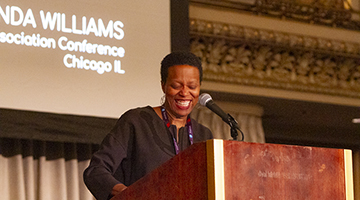
Amanda Williams speaks at Convocation at CAA’s 108th Annual Conference in Chicago
Awards for Distinction Juries
CAA has vacancies in the following juries for the annual Awards for Distinction for three years (2020–2023). Terms begin in July 2021.
- Art Journal Award, one vacancy
- Charles Rufus Morey Book Award for non-catalogue books in the history of art, two vacancies
- Jury for the Artist Award for Distinguished Body of Work, Distinguished Artist Award for Lifetime Achievement, and Distinguished Teaching of Art Award, two vacancies
- Jury for the Distinguished Teaching of Art History Award and the Distinguished Lifetime Achievement Award for Writing on Art, one vacancy
- Distinguished Feminist Awards for Scholars and Artists, two vacancies
- CAA/American Institute for Conservation Award for Distinction in Scholarship and Conservation, one vacancy
Publication Grant Juries
CAA has vacancies on our Wyeth Foundation Publication Grant jury for three years (2021–2024) and the Terra Foundation for American Art Publication Grant jury for one year (2021 –2022).
- Wyeth Foundation Publication Grant in American Art, two vacancies
- Terra Foundation for American Art Publication Grant, three vacancies
Professional Development Fellowship Juries
CAA has vacancies on our Professional Development Fellowship juries for three years (2021–2024). Terms begin July 2021.
- Professional Development Fellowship in Visual Arts, two vacancies
- Professional Development Fellowship in Art History, two vacancies
Travel/Support Grant Juries
CAA has vacancies on our jury for three years (2021–2024). Terms begin July 2021.
- CAA Support Grant in Memory of Archibald Cason Edwards, Senior, and Sarah Stanley Gordon Edwards, one vacancy
How to Apply
Nominations and self-nominations should include a brief statement (no more than 150 words) outlining the individual’s qualifications and experience and a CV (an abbreviated CV no more than two pages may be submitted). Please send all materials by email to Cali Buckley: cbuckley@collegeart.org. Nominations must be sent as a Microsoft Word or Adobe PDF attachment.
For questions about jury service and responsibilities, contact Tiffany Dugan, CAA Director of Constituency Engagement: tdugan@collegeart.org.
Deadline: July 14, 2021
CWA Picks: May 2021
posted by CAA — Jun 04, 2021
The May Picks from the Committee on Women in the Arts highlight a selection of events, exhibitions and calls for work that include feminist and womxn artists, and address issues about social justice, climate change and the ongoing global pandemic. Several of the exhibits expand and rework traditional narratives of American history, providing a more inclusive account of our country’s past and its current state.
Sonya Clark: Heavenly Bound
April 10 – September 12, 2021
deCordova Sculpture Park and Museum
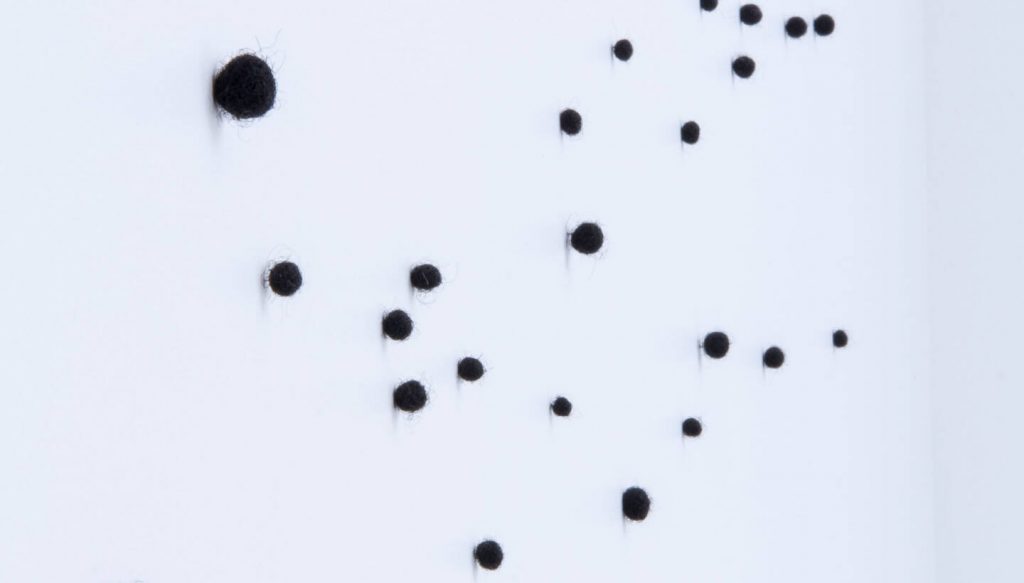
Sonya Clark’s Heavenly Bound, currently on view at the deCordova Museum and Sculpture Park, explores the Underground Railroad and its connection to those seeking freedom throughout history and today. The piece includes a series of large-scale photographs of abolitionists, a night sky made up of the artist’s hair, a parachute installation and a book of cyanotype constellations, which all reference the treacherous journey that self-emancipated Black Americans experienced during their escape.
Personal and Political: Women Photographers, 1965–1985
May 1 – November 28, 2021

Adriana Lestido, Mother and Daughter from Mothers of Plaza de Mayo, 1982. Courtesy Museum of Fine Arts, Boston
Personal and Political: Women Photographers, 1965–1985 includes the work of many well-known American photographers including Diane Arbus and Nan Goldin alongside recently acquired works by lesser-known artists working internationally such as Adriana Lestido and Paz Errázuriz. The exhibit focuses on a specific time in photographic history when women were becoming professional photographers at a higher rate than ever before.
Sharon Harper: Returning Light
April 9 – June 25, 2021
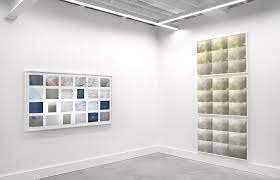
Installation view
Sharon Harper’s Returning Light, currently on view at Rivalry Projects, includes several series of photographs that investigate the cycles of light, providing a more macro view of time and space. Through the imprint of light Harper’s work instills a sense of awe and points toward the changing climate and landscape of our world.
Ground/work
Aug 1, 2020 – Oct 1, 2021
Ground/work includes the installation work of Kelly Akashi, Nairy Baghramian, Jennie C. Jones, Eva LeWitt, Analia Saban, and Haegue Yang. Each of the site-specific pieces considers the relationship between sculpture and nature as well as notions of time, scale and transformation.
Judy Chicago Art Education award
Deadline: June 1, 2021
The Judy Chicago Art Education Award is open to scholars, artists, and educators whose projects engage with the Judy Chicago Research Portal. The award includes a $2,500 prize along with a certificate to be presented in July 2021 in Belen, New Mexico.
Allison Katz: Artery
May 22 – October 31, 2021
Allison Katz’s exhibition, Artery includes paintings, ceramics and posters created in the past 18-months during a time of ongoing national lockdowns. The title of the exhibit speaks to the artist’s interest in networks and systems of connection as well as the spaces in between what is shared and private. Katz’s work will be on display at Nottingham Contemporary through October 2021 and will then be revisualized for the Camden Art Centre in January 2022.
On Hannah Arendt: What is Authority?
April 26 – June 6, 2021
What is Authority? exhibits work from Lili Dujourie, Everlyn Nicodemus, Lerato Shadi and sound artist Laima Leyton. The exhibit is part of a year-long series of shows inspired by Hannah Arendt’s writings about power structures.
Girl You Want
May 1 – August 1, 2021

Genevieve Gaignard, Black is Beautiful, 2016. Installation view in ArtYard’s gallery, 2021. Courtesy of the artist and Vielmetter, Los Angeles, photo by Paul Warchol
Girl You Want, curated by J. Vanessa Lyon, includes the work of Genevieve Gaignard, Julia Greenburger, Jen Liu, Josh Rabineau, Wendy and Beatrice Red Star, Karinne Smith, Ivy Stewart, and María Vargas Aguilar. The exhibit is a broad exploration of what it means to be a girl and traverses the space between girlhood and adulthood.
Promise, Witness, Remembrance
April 7 – June 6, 2021
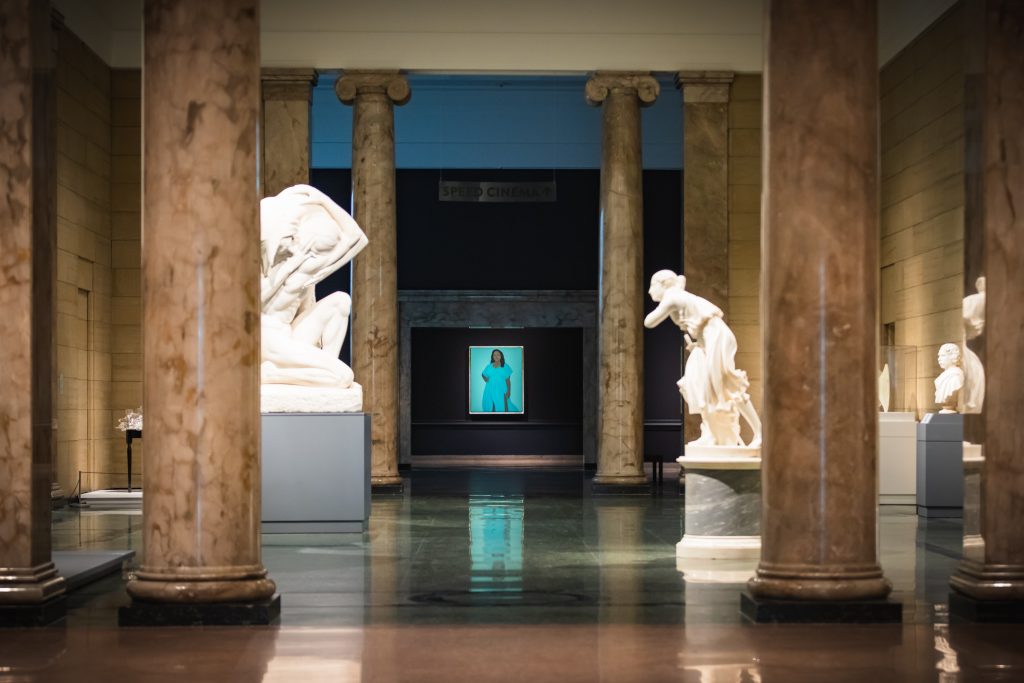
Installation view, Promise, Witness, Remembrance, Speed Art Museum, Louisville, Kentucky. Photo by Xavier Burrell
Promise, Witness, Remembrance was created under the direction of Breonna Taylor’s family along with a committee of artists, mental health professionals and community members. The exhibit pays tribute to Taylor’s life, reflecting on her killing in 2020 and the subsequent protests that took place both locally in Louisville and globally. The artists in this exhibit explore the disconnect between what the American dream has promised and the reality for many of its citizens.
Artist Residency
Deadline: October 1, 2021
Turkey Land Cove Foundation (TLC) offers a residency opportunity in Martha’s Vineyard for women who are in any stage of a project from development to completion. TLC specifically supports applicants who could not otherwise personally finance a residency. Room and board along with travel expenses are provided.
Call for Submissions
Deadline: July 15, 2021
For the 20th annual issue, Mom Egg Review is requesting submissions that respond to the idea of “Mother Figures.” Artwork and Literary pieces including poetry, nonfiction, short fiction, and hybrid works should be submitted by July 15, 2021 for consideration. You do not need to be a mother to participate.
Event: In Conversation with Dr. Nancy Odegaard
posted by CAA — May 18, 2021
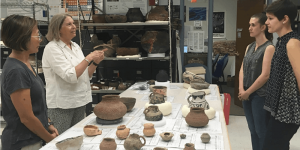
Dr. Nancy Odegaard discusses a strategy of pottery condition reporting with interns as a type of triage, or assignment of conservation treatments based on the types of damage or documentation need when a large volume of vessels are involved. The annual activity known as the Pottery Blitz has been a regular summer activity for many years at the Arizona State Museum.
Watch the recording of our virtual celebration of Dr. Nancy Odegaard, this year’s recipient of the CAA/American Institute for Conservation (AIC) Award for Distinction in Scholarship and Conservation.
Dr. Odegaard’s scholarship and gracious leadership have been central to modeling collaboration between disciplines, advancing conservation discourse, and fostering a more inclusive and nuanced understanding of art and cultural heritage. She has authored several publications that have become standards in the field for conservators, academics in the arts, and students.
The CAA/AIC Award for Distinction in Scholarship and Conservation annually recognizes outstanding contributions by one or more persons who, individually or jointly, have enhanced understanding of art through the application of knowledge and experience in conservation, art history, and art.
This event was produced in partnership with CAA’s affiliate organization, the American Institute for Conservation (AIC) in tandem with their 2021 AIC/SPNHC Joint Virtual Annual Meeting.
Meet the 2020 Professional Development Fellows
posted by CAA — Apr 19, 2021
CAA is pleased to announce the recipient of the 2020 Professional Development Fellowships. The recipient of the $10,000 fellowship in visual art is Ana Maria Farina, SUNY New Paltz. A fellowship in art history was not awarded this year.
The honorable mention in visual art is awarded to Sabrina Pastard, Columbia College Chicago. All fellows and honorable mentions receive a complimentary one-year CAA membership and registration for the 2022 Annual Conference in Chicago.
2020 PROFESSIONAL DEVELOPMENT FELLOWSHIP IN VISUAL ARTS
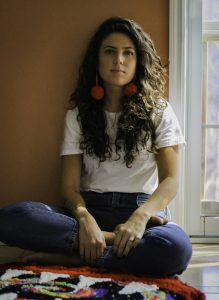
Ana Maria Farina, SUNY New Paltz
Ana Maria Farina paints using a gun––a tufting gun––along with needles, hooks, and knots. Repurposing a phallic signifier of violence, she conjures vibrant objects of comfort that inhabit a mystical pictorial space between abstraction and representation.
Ana Maria was born and raised in Brazil and is now based in the Hudson Valley, New York. She received her masters degree in Art and Art Education from Columbia University in 2016, and in 2018 she was awarded a fellowship to the New York Foundation for the Arts Immigrant Artist Mentoring Program. In 2019, she received a scholarship to attend the MFA program at SUNY New Paltz, where she also served as the Visiting Artist Director and Instructor of Record. Ana’s work has been featured in many spaces throughout New York and she has upcoming exhibitions at the Wassaic Project, the Garrison Art Center, the Dorsky Museum, among others.
HONORABLE MENTION IN VISUAL ART
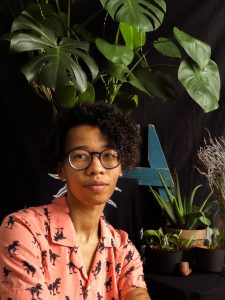
Sabrina Pastard, Columbia College Chicago
Sabrina Pastard is a visual artist who works with the poetics in the meta of the mundane. Often balancing her visuals on the borderline of familiarity and the abject, safety and crisis. Her multidisciplinary practice ranges in medium from ready-made sculptures and abstract prints to conceptual writings and poetry. Each new work invites an intellectual intimacy from the viewer as it inquires to the status of our assumed lives and societal taboos. Pastard was raised in St. Louis, MO and received her B.A. in studio art from George Fox University. She currently resides in Chicago and will complete her MFA at Columbia College Chicago in May 2021.
ABOUT THE PROFESSIONAL DEVELOPMENT FELLOWSHIP
CAA’s Professional Development Fellowship program supports promising artists and art historians who are enrolled in MFA and PhD programs nationwide. Awards are intended to help them with various aspects of their work, whether for job-search expenses or purchasing materials for the studio. CAA believes a grant of this kind, without contingencies, can best facilitate the transition between graduate studies and professional careers. The program is open to all eligible graduate students in the visual arts and art history. Applications for the 2021 fellowship cycle will be due December 15, 2021. Learn more.
CAA at 2021 Advocacy Days
posted by CAA — Apr 16, 2021
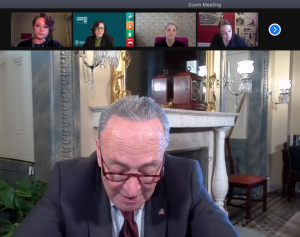
Screenshot of CAA in virtual conversation with NY Senator Chuck Schumer, 2021
CAA representatives advocated for the arts and humanities with partners at the American Association of Museums (AAM) and the National Humanities Alliance (NHA) this spring for Museums Advocacy Day on February 23 and Humanities Advocacy Day on March 11, 2021. Alongside other academic societies, scholars, and museum professionals, CAA urged congressional representatives and senators to back full funding for the National Endowment for the Arts (NEA), the National Endowment for the Humanities (NEH) and particularly the Institute for Museum and Library Services (IMLS), which provides grants for museums and arts organizations throughout the country, for the fiscal year 2022. Increased allocations for these programs would bring funding levels back to what they were over a decade ago in 1998. We met with the offices of New York representatives Tom Reed, Jerry Nadler, Carolyn Maloney, John Katko, and Yvette Clarke and senators Kirsten Gillibrand and Chuck Schumer. Sen. Schumer joined Museums Advocacy Day in person to share his enthusiasm about moving forward with emergency relief funds for arts organizations and supporting more space for them in the next year’s congressional budget.
CAA has been participating in these meetings for the past three years. We noted that 1/3 of all museums in the US are at risk of closing without assistance. We also stressed the importance of museums as institutions that have served our community greatly during COVID and have come up with creative solutions for childhood education, community building, virtual exhibitions, and out-of-the-box engagement strategies. The arts and humanities have helped our communities cope and their spaces—schools, libraries, and museums—remain some of the only spaces in communities that can be accessed freely by the public.



